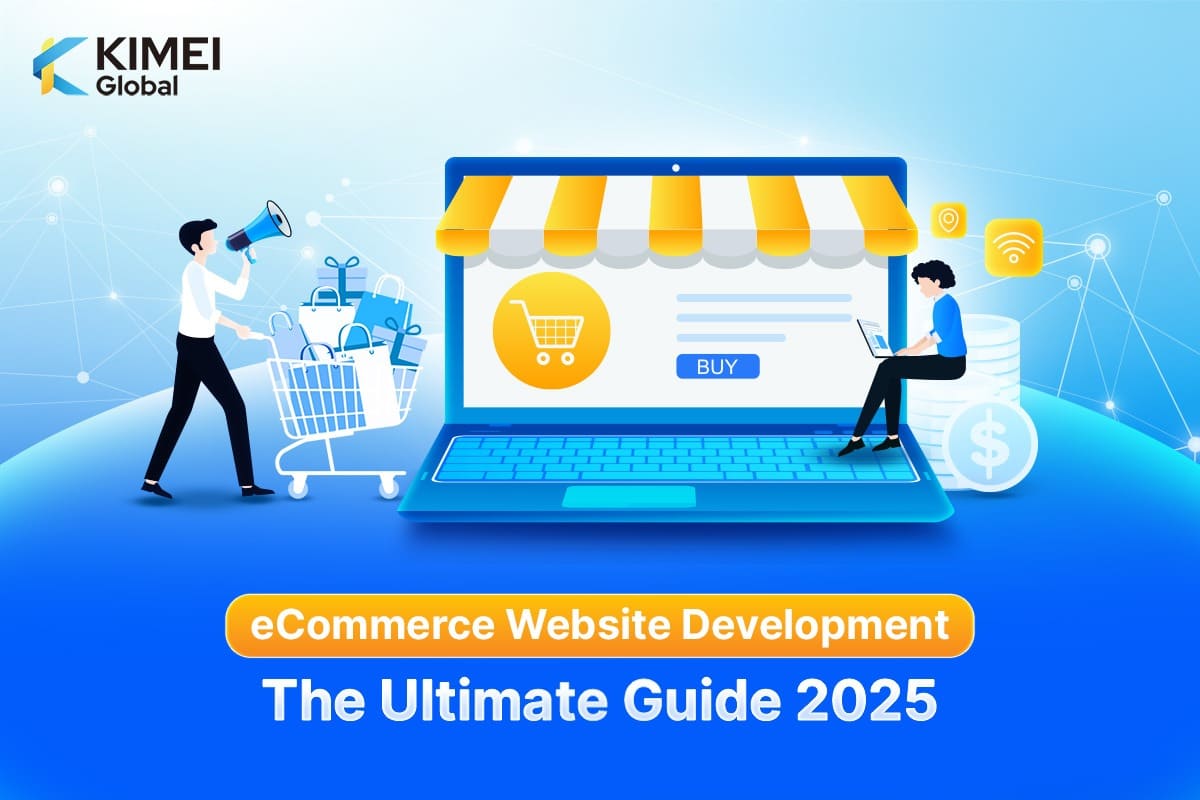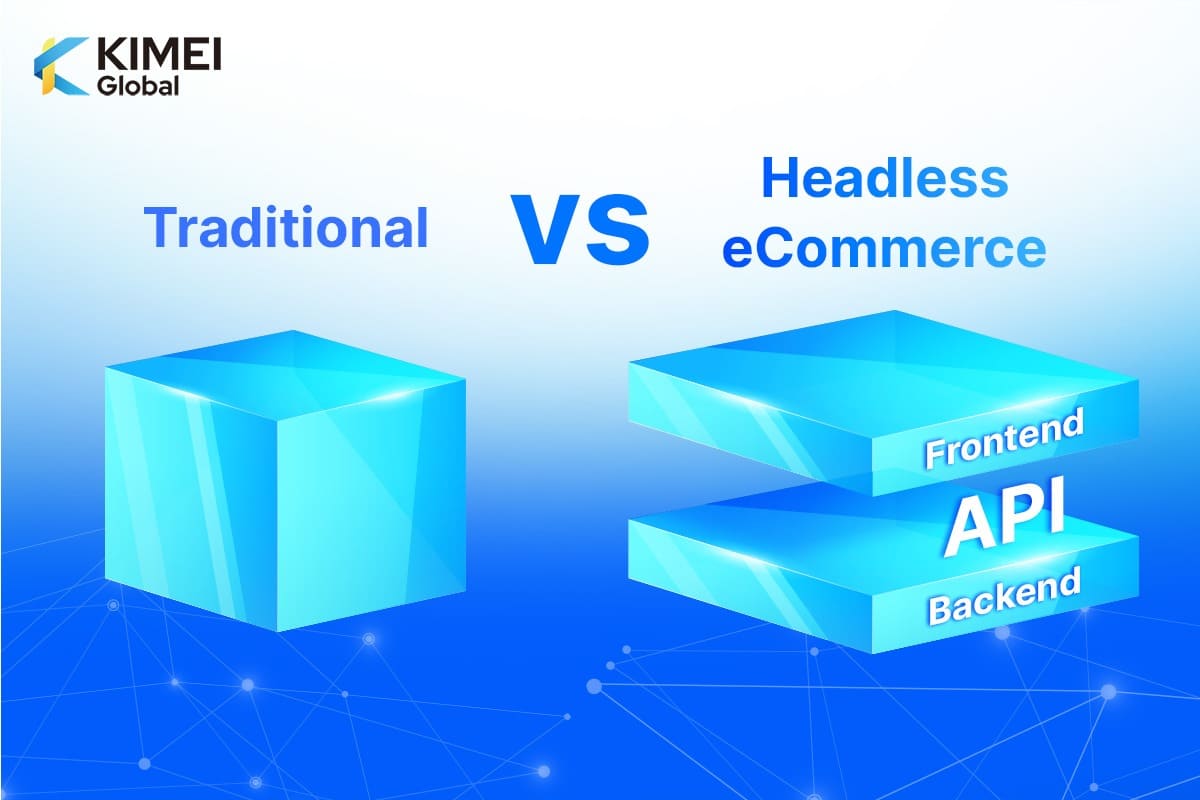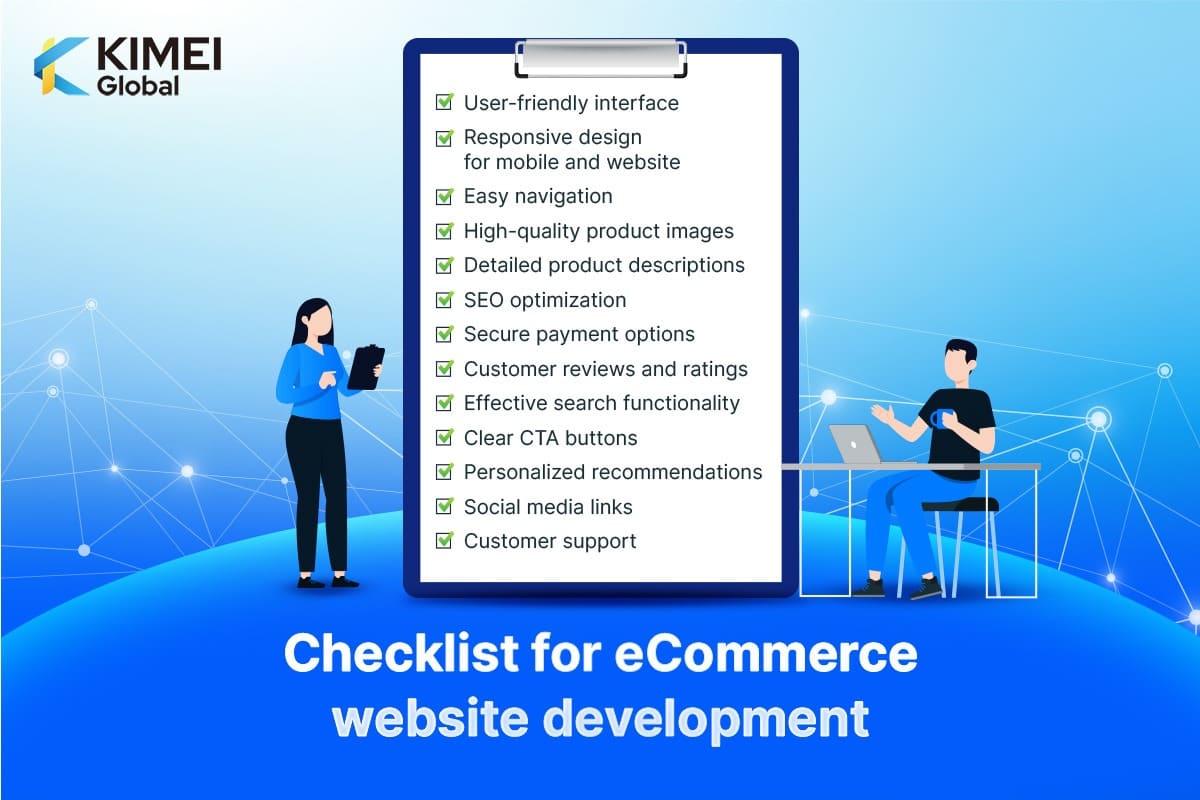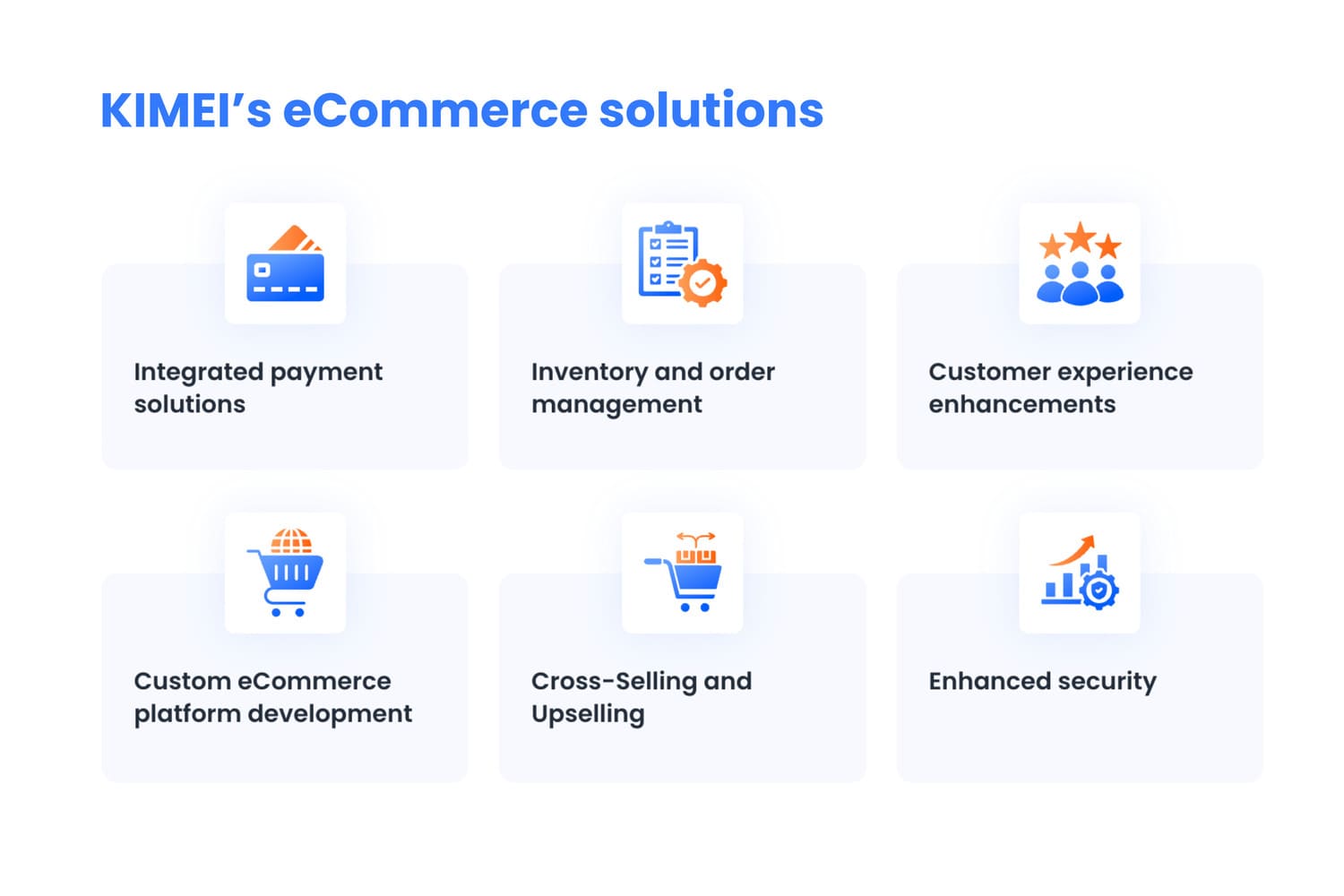eCommerce Website Development: The Ultimate Guide 2025
eCommerce Website Development: The Ultimate Guide 2025
KIMEI Global
3月 31, 2025
Learn everything you need to know about eCommerce website development in 2025 with strategies, options, and expert tips from KIMEI Global.
In the ever-evolving digital landscape, having a robust eCommerce website is no longer optional — it's a necessity for businesses striving for success. Whether you’re launching a new online store or looking to upgrade your existing platform, understanding the intricacies of eCommerce website development is crucial. This comprehensive guide will walk you through the entire process, from choosing the right development approach to implementing the essential components that will drive growth and enhance customer experience. If you’re looking to stay ahead of the competition and deliver a seamless online shopping experience, you’re in the right place.

What is eCommerce website development?
eCommerce website development is the process of building the digital infrastructure that powers an online store. It involves creating both the visual elements users interact with and the behind-the-scenes systems that manage data, transactions, and integrations with essential business tools.
At its core, eCommerce development includes 3 components:
-
Frontend development: This includes everything the customer sees and interacts with on your website — from homepage layout and product pages to navigation, filtering, and the checkout experience. A well-crafted frontend ensures a smooth, intuitive shopping journey that encourages users to explore and buy.
-
Backend development: The backend powers the functionality behind the scenes. It handles tasks like managing product databases, processing orders, updating inventory, storing customer information, and connecting with payment systems. It’s the engine that keeps the entire store running efficiently.
-
Third-party integrations: Modern eCommerce websites rely heavily on integrations to extend their capabilities. This may include payment gateways (like Stripe or PayPal), shipping services, marketing tools, analytics platforms, and customer relationship management (CRM) systems. These connections streamline operations and improve both customer experience and internal workflows.
In traditional eCommerce, websites typically operated with monolithic architecture, where the frontend (what users see) and backend (data management and logic) were tightly connected. This meant that any changes to one part often required adjustments to the other, making it difficult to quickly scale or update the site.
However, with the rise of headless commerce, the frontend and backend are decoupled, allowing businesses to update one without affecting the other. This flexibility enables the creation of personalized experiences across various digital touchpoints while maintaining a single source of truth for content and data.

Why eCommerce website development matters for business growth
In today’s digital-first world, a well-structured eCommerce site serves as more than just an online store — it’s the cornerstone of your business’s success. It influences everything from user experience to brand credibility and ultimately affects your revenue stream.
-
Set the first impression
Your eCommerce website is often the first point of contact with potential customers. A professional, well-designed site can immediately communicate your brand’s identity, values, and trustworthiness. A seamless, intuitive user experience will ensure visitors stay longer, reducing bounce rates and increasing the likelihood of conversions.
-
Create a straightforward shopping experience
Effective eCommerce website development focuses on crafting an intuitive experience for users. Features like easy navigation, clear product categories, quick search functions, and a smooth checkout process can all contribute to a positive shopping experience. When customers can easily find what they’re looking for and complete their purchases without friction, it boosts both satisfaction and the chances of repeat business.
Features like upselling, personalized recommendations, and discount options of an eCommerce website can also help boost average order values, increasing sales and revenue for your business.
-
Gaining organic traffic
eCommerce website development and SEO go hand in hand. A well-designed, user-friendly site optimized for search engines has a higher chance of attracting organic traffic, improving visibility, and driving sales. By focusing on essential SEO elements like fast page load times, clean URLs, mobile responsiveness, optimized content, and schema markup, you can improve your website’s ranking on search engines and drive more traffic to your eCommerce store. SEO best practices in the development phase help lay the groundwork for sustained growth by ensuring that your site is discoverable and provides a seamless experience to users.
-
Reaching customers beyond physical locations
An eCommerce website isn’t just for selling products - it’s an opportunity to share your brand with the world. By going online, you open up your business to a global audience, reaching customers beyond your physical location. Your website becomes a gateway to new markets, helping raise brand awareness and introduce your products to people you might not have reached before.
-
Stay competitive in a digital world
In the rapidly changing market, having an eCommerce store is no longer optional — it’s a necessity. Without an online presence, businesses risk falling behind competitors who have embraced digital sales channels. By investing in eCommerce website development, you’re not only keeping up with the times but also positioning yourself as a forward-thinking brand that understands consumer behavior and adapts to the digital marketplace.
With eCommerce expected to account for more than 21% of worldwide retail sales compared to 17% in 2024 by Statista (2025), investing in eCommerce website development is a strategic move that can shape your business’s future success.
Whether you’re just starting or scaling up, the right development approach can set the foundation for long-term growth, customer loyalty, and competitive advantage. Learn more about KIMEI Global eCommerce solutions and see how we can support your digital transformation.
3 options for developing an eCommerce website
Choosing the right method for building your eCommerce website is crucial for growth, scalability, and delivering an optimal user experience. Each method comes with its own set of benefits, challenges, and costs. Here, we explore three main methods to help you choose the best fit for your business goals.
-
Building an eCommerce website from scratch (open source)
Building your eCommerce website from scratch using open-source platforms like Magento, WooCommerce, or PrestaShop allows you to create a completely tailored online store. These platforms provide full control over design, functionality, and integration, making them ideal for businesses with specific needs.
|
Benefits
|
Challenges
|
|
|
This approach is best suited for businesses that need a unique, high-performing website and have the technical resources to support its development and upkeep.
-
Customizing a SaaS (Software-as-a-Service) solution
For businesses seeking a quicker, more user-friendly solution, SaaS platforms like Shopify, BigCommerce, and Wix are popular choices. These platforms provide pre-built, cloud-based eCommerce solutions with the ability to customize themes, add plugins, and integrate payment systems.
|
Benefits
|
Challenges
|
|
|
SaaS platforms are ideal for businesses that need to launch quickly, keep costs manageable, and are comfortable with a standardized solution that can still be customized within certain limits.
-
Leveraging MACH architecture
MACH architecture (Microservices, API-first, Cloud-native, and Headless) is the latest innovation in eCommerce website development, enabling businesses to create highly flexible, scalable, and future-proof websites. With MACH, the frontend and backend of the site are decoupled, offering businesses the ability to continuously evolve their customer-facing experience without disrupting the backend operations.
|
Benefits
|
Challenges
|
|
|
MACH architecture is ideal for businesses looking for the highest level of customization and flexibility, especially for large-scale eCommerce operations that require constant innovation and future adaptability.
6 steps for developing a custom eCommerce website
Developing a custom eCommerce website is an exciting yet complex process. While there are tools and platforms that simplify the process, building a robust, scalable, and user-friendly online store requires strategic planning and careful execution. Here are 6 essential steps to guide you through the process of eCommerce website development:
-
Establish clear business goals and metrics
The decision to create an online store is just the first step; real planning comes in defining your specific business goals. Consider what you hope to achieve through eCommerce.
- Are you focused on direct-to-consumer (D2C) sales?
- Or are you looking to drive traffic to complement your physical store?
- Perhaps you're expanding from B2C to B2B, or vice versa.
Think about your growth metrics.
- What do you expect in terms of online sales volume, and how will you measure success?
- Will you target local or international markets?
- How will you encourage customer retention and boost lifetime value?
Defining these goals early will help you make informed decisions throughout the development process and ensure the platform can scale to meet your business ambitions.
-
Design the shopping experience for your customers
Think of it as a roadmap guiding users from landing on your site to completing a purchase, and hopefully coming back again.
Consider these design elements:
-
Easy navigation: Ensure your product categories are easy to find, with a search function that allows customers to filter by size, color, price, etc.
-
Product comparison tools: Give customers the ability to compare products side-by-side to help them make informed decisions.
-
Optimized checkout: Streamline the checkout process with auto-filled forms, express checkout options, and guest checkout capabilities to minimize friction during purchase.
-
Personalized recommendations: Integrate features that suggest related or complementary products based on browsing behavior to increase cross-selling opportunities.
Your shopping experience should reflect your customer’s preferences — whether they want a fast and straightforward purchase or enjoy browsing and discovering new items.t
-
Choose the right eCommerce platform for development
One of the most critical decisions in your eCommerce website development process is choosing the right platform. Different platforms have distinct strengths depending on your business size, growth potential, and technical capabilities.
- Open-source solutions: Magento, WooCommerce…
- SaaS platforms: Shopify, BigCommerce, Wix…
- MACH architecture
When selecting a platform, assess your budget, technical resources, and the scalability you need for future growth. It’s also important to remember that you don’t have to handle everything on your own. If you lack the technical expertise or resources to implement these platforms, outsourcing the development process to a trusted partner can save time and ensure a professional result. Find out the Top 10 Offshore Software Development Companies for eCommerce in Vietnam 2025.
-
Create and organize your product catalog
Once your platform is selected, it’s time to populate your store with products. This step involves not only uploading products but also ensuring that the listings are well optimized for search engines and user experience.
Key elements to focus on:
- High-quality images: Professional photos enhance customer confidence in the product.
- Detailed descriptions: Include specs, sizing guides, and care instructions.
- Stock management: Sync inventory across all channels to avoid overselling.
- Product categorization: Organize products with filters and sorting for easy browsing.
Organizing your products efficiently not only helps customers find what they’re looking for quickly but also ensures your website remains user-friendly.
-
Set up payment and shipping systems
A smooth checkout process is essential to convert visitors into customers. During the development phase, setting up the right payment gateways and shipping options will ensure that customers can complete their purchases with ease.
-
Payment options: Offer various methods like credit cards, PayPal, and BNPL, with support for multiple currencies for international sales.
-
Shipping configuration: Set real-time shipping rates, integrate logistics partners (UPS, FedEx, DHL), and ensure easy international shipping with proper taxes and duties.
-
Tax settings: Automate tax calculations based on location for accuracy and compliance.
-
Conduct thorough QA testing before launch
Once your eCommerce website is set up, it’s time to test everything thoroughly before going live. This is a critical step that ensures your site functions smoothly and provides a positive user experience.
Here’s an eCommerce website development checklist for your QA process:

How KIMEI Global simplifies eCommerce website development?
Building a successful eCommerce website can be complex — but with the right partner, it doesn’t have to be.
At KIMEI Global, we specialize in creating custom, scalable, and high-performing eCommerce solutions that drive business growth. Whether you’re launching your first online store or looking to modernize an existing platform, our team provides end-to-end support to simplify the development process and accelerate your path to digital success.

-
End-to-end eCommerce solutions: We design and implement everything from user-friendly frontends to powerful backends, payment systems, and logistics integrations, ensuring your platform is secure, scalable, and ready for growth.
-
Tailored approach to your business: No two businesses are alike — and neither should their websites be. That’s why we take the time to understand your goals, target markets, and operational workflows to best serve your vision and growth plan.
-
Proven track record in global markets: KIMEI Global has a proven track record of driving digital success for leading brands. Check out our case studies to see how we’ve delivered impactful eCommerce solutions.
-
Your strategic offshore development partner: With extensive experience in IT outsourcing, KIMEI Global provides dedicated offshore development teams that enable businesses to scale rapidly and efficiently. Our model delivers access to top-tier engineering talent, reduces operational costs, and accelerates project timelines, ensuring high-quality results without compromising on performance.
- Deep expertise in custom eCommerce website development
- Agile development with a focus on speed, security, and scalability
- Multinational experience with clients in Japan, Hong Kong, Taiwan, and North America
- Transparent communication and long-term partnership mindset
- Strong cultural alignment and collaboration-first approach
- People, Trust, Quality, and Heart are prioritized in every project
If you're ready to take your digital presence to the next level, contact us to drive your business growth and success.
2 real-world examples of great eCommerce websites
-
Le Creuset: A premium cookware brand’s global migration
Le Creuset, famous for its premium cast-iron cookware, has established itself as a leader in the kitchenware industry. With a strong customer base across different regions, the brand needed a scalable and efficient eCommerce solution to enhance its global presence.
Key Features:
- Multi-region product catalogs
- Customizable shopping experiences for different markets
- Optimized backend for scalability and performance
Le Creuset partnered with KIMEI Global to migrate their existing eCommerce platform and integrate it across various regions. By optimizing system performance and ensuring smooth integration, we created a seamless shopping experience for customers globally. Our solutions also addressed regional challenges, helping Le Creuset expand its reach with localized content, payment systems, and product information.
-
Data privacy compliance with local regulations
-
Localized payment systems and shipping options
-
Multilingual support for customers
Conclusion
A well-developed eCommerce website is key to your business's growth and success. By choosing the right development approach and ensuring a seamless user experience, you can boost customer satisfaction and drive sales. At KIMEI Global, we’re here to simplify the process and help you build a scalable, high-performing eCommerce platform.
FAQ
-
How long does it take to develop an eCommerce website?
The timeline for developing an eCommerce website typically ranges from 3 to 6 months. This depends on factors such as the complexity of the design, features, and integrations required.
- Basic websites (e.g., Shopify): A few days to 3 – 5 months.
- Moderate websites (e.g., Magento): 6 – 9 months.
- Complex websites (e.g., Amazon): 9 months to 1 year or more.
-
How much does it cost to develop a custom eCommerce website?
The cost of building a custom eCommerce website varies based on complexity, features, and the development team's expertise. On average, the cost can range from $5,000 to $50,000 or more, depending on the scope of the project. Additional ongoing costs may include maintenance, hosting, and marketing.
-
Can I scale my eCommerce website as my business grows?
Yes, scalability is essential for growth. Platforms like SaaS and MACH architecture are designed to handle increased traffic, product catalog expansions, and new features without disrupting performance. Properly planning for scalability ensures that your eCommerce site can accommodate business growth without sacrificing user experience.
-
How can I track and analyze user behavior on my eCommerce site?
Tools like Google Analytics, Hotjar, and Crazy Egg allow you to monitor user behavior on your site. You can track where visitors are clicking, how they navigate, and where they drop off, enabling you to optimize the user experience. Using heatmaps and session recordings helps improve your site's design based on real user data.

